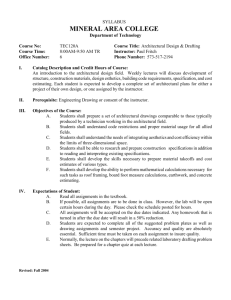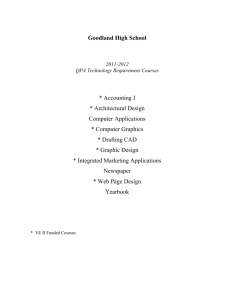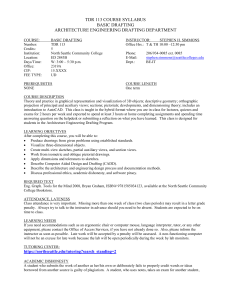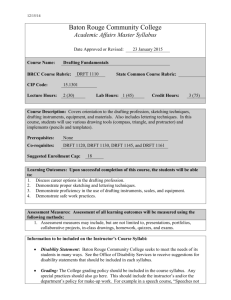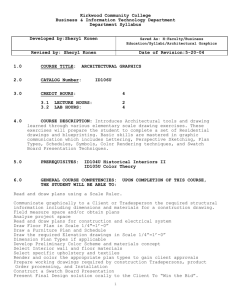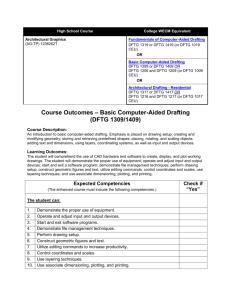An Introduction
advertisement
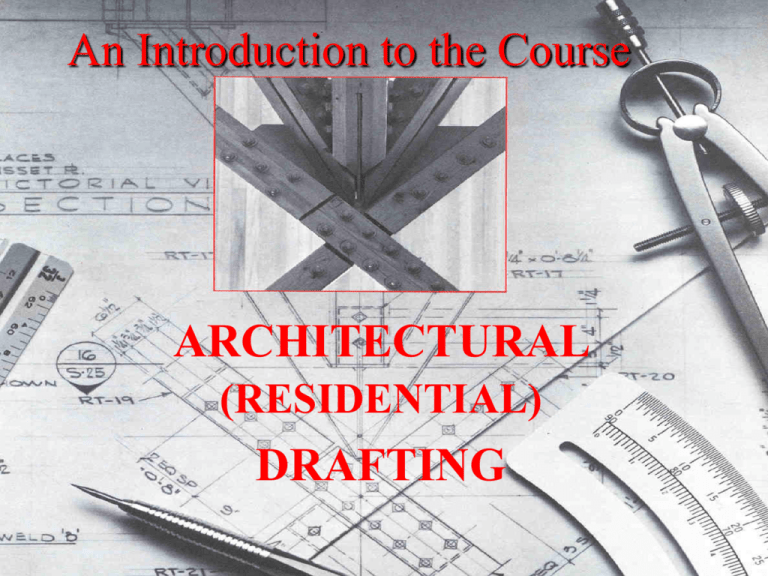
An Introduction to the Course ARCHITECTURAL (RESIDENTIAL) DRAFTING Department Mission Statement The mission of the Drafting Technology Department coincides with the institutional mission: to provide quality vocational and technical training to students for employment, to assist students to attain educational and personal goals, and to provide occupational training and vocational/technical information for the community. Class Standards • Dress standards – good taste, common sense, high moral standards are the watchwords for dress and grooming – no hats in classroom Course Syllabus Syllabus--A summary outline of a concurrent enrollment course for Weber State University “It is the peculiarity of knowledge that those who really thirst for it always get it.” “If you don’t have time to do it right at first, when will you have time to do it over?” “It’s a cinch by the inch, but hard by the yard!” “We learn wisdom from failure much more often than from success. We often discover what will do, by finding out what will not do.” Course Catalog Description A course for Drafting Technology students who wish to broaden his or her basic drafting skills in the field of residential architectural drafting. This course covers procedures used in developing a complete set of residential plans. Includes architectural drafting standards, handlettering procedures, and code requirements. • The term Details covers the broad category of isolated and enlarged drawings • Details along with the plans, elevations, etc., and specifications form the complete set of construction documents. • Knowledge of construction details should give a clear assembly of parts that form a portion of the total package of construction. • Knowing the particulars of materials that make-up a detail allows the drafter, designer, or architect to conceptualize faster and get the work completed. Course Disclaimer The instructor reserves the right to make changes, deletions, corrections, or additions during the course. These changes will be announced in class. Anyone with special needs or learning disabilities needs to bring that to my attention. Course Overview • • • • 3 credit hour course 3 +/- hours/week lecture 5 +/- hours/week lab 10-12+/- hours/week independent study, research, class preparation [reading, etc.], and doing drafting assignments Course Objectives • 1--Become acquainted with the materials that makeup details. • 2--Approach detailing logically and systematically. • 3--Know the difference between structural detailing as it applies to aesthetics, and environment. • 4--Deal with certain confinements and limitations of creating the detail. • 5--Develop an appreciation for the work that is involved in creating details. • 6--Demonstrate the skills associated with detailing • 7--Develop line quality, techniques and presentation skills in drafting the detail, Course Objectives • 8--Become acquainted with various facets of construction for details: – – – – – – – – lumber and metal connections welding masonry footing and concrete connections exterior wall sections roof connections, door and window construction stairway and fireplace construction • 9--Develop a portfolio of architectural details Drawing Project • Drawings Required: Plot/landscape plan w/ drawing index(1sht), FTG/FDN plan (1sht), Floor plans(2sht), Front Elevation (1sht), Door/Window Schedules, and Stair section, Fireplace details, and Typical wall section, Electrical plans with Electrical symbol legend combined with drawings on other sheets. • Drawing for extra credit: elevation(3 possible), stairs elevation, porch section, cross-section, and others by approval Organization of the Course • Organized into Units of Study – time of unit based upon complexity of material – assignments given for each unit • Reading assignments must be done before lecture • Suggested to answer chapter questions and terminology Teaching Methods • Lectures and discussion periods – Students should get involved – Ask questions • PowerPoint presentations • Attendance is taken, students are required to attend presentations • Drafting lab/studio time, drafting time outside of class time is required • Suggested for students to follow class schedule and come prepared for each class period. Grading and Evaluation • • • • • • Drawings – 50 points each – 30% of grade Lettering – 10 points each – 10% of grade Homework (W/S) – points vary – 10% of grade Full set of drawings – 600 points – 25% of grade Test and Quizzes – points vary – 25% of grade Possible extra credit – to be determined Oral Expression • Work towards learning architectural terms to expand your vocabulary and ability to communicate architecturally, see an architectural glossary get to work and start increasing your vocabulary. Drawing Assignments • 20+/- possible drawings to help develop drafting skills using line quality, line techniques, and an understanding of how building are put together • You will be doing the assignments on CAD and you are eligible for a copy of the software to use at home • Follow the assignment schedule assignments are due one week after assigned at beginning of class. • NO WORK WILL BE ACCEPTE LATE – you can always turn it in early. Letter Grades of the Course • • • • • • 95-100% 86-89% 80-82% 73-76% 67-69% 60-62% A B+ BC D+ D- 90-94% 83-85% 77-79% 70-72% 63-66% <60% AB C+ CD E Equipment & Supplies • Required: 8-12 sheets of D size mylar or plot paper (depending on if you are using CAD or Manual drafting styles). You will get one print – additional prints will be at your expense. • Note: only required for those on the boards – – – – – – – – – – Pencils your preference (Mechanical or Metric) Leads (from 4H to F or HB, your preference) Drafting erasers (pink pearl or nylon/vinyl) Drafting tape, erasing shield, & drafting brush Architectural scale Triangles: 45 & 30-60 Lead pointer depends upon what pencils you use Circle template Lettering guide French curve • • • • • Drafting Pencils Drafting Leads Drafting Erasers Erasing Shield Drafting Brush • • • • • Scales Triangles Templates Circle French Curve Drafting Vellum • A. Mechanical Pencil-one diameter of lead but requires a lead pointer or sharpener • B. Automatic Metric Pencil--requires several grades of leads and mm diameters, 0.3, 0.5, 0.7, 0.9 mm diameters are available A . B . • Leads are graded from 9H (hard) to F (firm) to 6B (soft) with 4H to HB most common for architectural work. • Mechanical Pencil: – 4H, 2H, H, F or HB • Automatic Metric Pencil: – 4H for 0.3 mm pencil – 2H, H for 0.5 and 0.7 mm pencil – F for 0.9 mm pencil • Pink Pearl • Mylar Plastic • Metal erasing shield--used to erasing lines close to objects of the drawing that you wish not to disturb. • Used to sweep erasing crumbs and excess graphite from the drawing sheet. Using the brush is important to keep drawing clean. • Architectural Scale --used for all building drawings and details • Civil Engineer Scale --used for plot plans and all types of land related drawings Words written on scales to indicate type • Floor Plan Template-1/4” scale, has appliances, plumbing fixtures, doors, etc. • Circle Template • Triangles: – 45 Degree – 30-60 Degree – Adjustable • French Curve • Protractor Parts to Know: 1--Base-line wingnut 2--Protractor brake wing-nut 5 3--Protractor 3 4--Vernier plate 5--Index release 1 2 Angular Measurement Tools for Lettering • • • • • • Drafting Pencils Drafting Leads Ames Lettering Guide Triangle Drafting Machine Vellum • What leads to used for architectural lettering: Common leads for lettering: F, H, 2H 2” measurement with 1/8” increments Ames Lettering Guide Rotate wheel 1/8 ” Setting for 1/8 spacing between each hole • 1--No lines are on your drawing vellum to start with, therefore needed to give size of lettering. • 2--Architectural drawing is a form of technical drawing, tools and instruments are used to create straight line and legible work. • 3--All lettering is done using guidelines. • 4--General rule for guide lines for lettering height: – 1/8” for notes and dimensions – 3/16” for room titles – 1/4” for drawing titles Architectural Lettering Styles • Handout Information: – Proficiency in lettering is valuable and important – Make lettering consistent, readable, legible, and fast is the ultimate – Architectural lettering generally has evolved from many influences – Usually architectural offices have a uniform style of lettering – Practice, be persistent, and make the effort to do “Triangle or Straight Edge Vertical Stroke” lettering it will be worth it – A requirement of the course Architectural Lettering Style • Triangle or Straight Edge Vertical Stroke lettering • All vertical strokes are made with the triangle • Fast & popular architectural style variations variations Example of Triangle Lettering Triangle Lettering Positions Architectural Lettering Exercises • Instructions and Format: – – – – “D” size vellum or mylar Title Block as outlined Title (heading) of exercise 1/8” high Lettering 3/32” high with 1/16” spacing between lines of lettering “A” size Title Block Architectural Lettering Exercise Suggestions MORE SPACE MORE SPACE MORE SPACE Classroom Conduct Unacceptable Conduct Acceptable Conduct Horseplay or rowdiness Sleeping Drinking or Eating Honesty I n t e r n e t Alertness Promptness Good Attitude Hard Work Sheet Layout Handout Acceptable title block positions. Remember that drawings will be placed in your portfolio and should be readable like a book The Design Sketching Brain Storm Analysis Process Key Items to Include • • • • • Logo Name of Company Personal Name Address (Local) Telephone Number (Local) Chapter 1 Professional, Architectural Careers, Office Practice, and Opportunities Links for Chapter 1 Architectural Careers Design Basics The Design Process Related Web Sites Architectural Careers • Beginning Drafter - Entry level position to gain experience and skill • Experienced Drafter - Expected to make construction decisions based on initial designs • Positions are available with architects, engineers, and designers Architectural Careers • Designer - May work under an architect and as a coordinator of many drafters - May design residential size building and dwellings • Architect - Must be licensed to practice – Designs residential and commercial buildings – Additional schooling beyond high school required – A variety of architectural careers available Architectural Careers • Engineer - Work is more technical and requires high level of math and science – Education beyond high school required – A variety of engineering fields available – Required to pass an examination for certification Architectural Careers • Illustrator - Combines artistic and architectural skills to produce drawings • Model Maker - Follows plans to build scale models Architectural Careers • Specification Writer - Understands the construction process to write necessary details of the plans • Inspector - Checks plans to ensure codes and laws have been followed Design Basics • Financial Considerations - Estimates for labor and material costs are calculated • The Client - Important to ensure that their desires in the project are being met accordingly The Design Process • Initial Contact - The designers and client meet to discuss design ideas, fees, schedules, and ensure personalities are compatible The Design Process • Preliminary Design Studies - Following the research, bubble drawings and scaled sketches are created – Rooms must be considered throughout this stage and may include room usage, furniture layout, and size requirements The Design Process • Initial Working Drawings - A drafter begins to make working drawings that include the foundation, plot, roof, electrical, cabinet, and framing plans • Final Design Considerations - A conference with the client is needed to discuss the initial working drawings The Design Process • Completion of Working Drawings - Drawings include at least: – – – – – (A) Architectural (S) Structural (M) Mechanical (E) Electrical (P) Plumbing The Design Process • Permit Procedures - Once all plans are complete appropriate permits must be secured before construction begins • Job Supervision - Although not usually done by the designer, sometimes he/she is required to go to the site and solve problems. Related Web Sites • • • • • Sweet’s System - www.sweets.com National Association of Home Builders - www.nahbrc.org Residential Architect Online - www.residentialarchitect.com Architect’s First Source for Products - www.afsonl.com American Institute of Building Design www.aibd.org • National Council of Building Design Certification – www.ncabdc.com • National Council of Architectural Registration Boards – www.ncarb.org Chapter 2 Architectural Drafting Equipment Links for Chapter 2 Drafting Supplies Drafting Instruments Drafting Machines Scales Drafting Supplies • Mechanical Pencils - The lead is manually inserted and sharpened as needed • Automatic Pencils - The lead advances as button or tip is pushed • Lead Grades - Depends on the type of line – Thick Lines - 2H to F – Thin Lines - 4H to H Drafting Supplies • Pencil Motion - Keep pencil tilted at 45º with the direction of travel – Provide even pressure to create sharp crisp lines – Slowly Rotate the mechanical pencil as the line is drawn – Practice this technique as often as possible Drafting Supplies • Technical Pens - Used to create inked lines • Erasers - Use the correct eraser for the job – Do not press too hard to rip the material – Erasing shields protect good lines – Use a dust brush to remove the eraser particles Drafting Instruments • Compasses - Used to draw circles and arcs – Drop-bow is used for small circles – Center-wheel is used by professional drafters – Beam is used for large arcs or circles • Keep the compass needle sharp and the lead point sharpened like a chisel point Drafting Instruments • Dividers - Used to transfer dimensions or divide distances • Parallel Bar - Slides up and down the drafting board by cables mounted on pulleys • Triangles - Two standard types – 30º-60º-90º is known as 30º-60º triangle – 45º-45º-90º is known as 45º triangle Drafting Instruments • Templates - A plastic sheet that contains standard symbols used for tracing – Be sure the scale matches your drawing – Keep both sides clean • Irregular Curves - There is no constant radii and is commonly called a French curve Drafting Machines • Arm Drafting Machine - The arm clamps to the table and the head can rotate to a variety of angles with different scales attached to it • Track Drafting Machine - The traversing arm moves left and right across the table and the head can also lock and pivot Scales • Notation - Scale of the drawing is noted in each title block – Architecture - 1/4”=1’-0” or 1”=1’-0” – Civil - 1”=50’ or 1”=500’ • Metric - Scale is based on the meter (m) unit – Millimeter (mm) is most commonly used on drawings Scales • Architect’s Scale - Contain 11 different scales – – – – – Locate the correct scale before beginning Ten of the scales are based on the inch unit Other scale is divided into 1/16th of an inch Be careful when reading from left to right The 1/4”=1’-0” is the most common scale Scales • Civil Engineer’s Scale - Contain 11 different scales – Locate the correct scale before beginning – The scales are based on the inch unit in multiples of 10 – Be careful when reading from left to right – The 50 scale is most popular Chapter 3 Drafting Media and Reproduction Methods Links for Chapter 3 Papers and Films Sheet Sizes & Layout Diazo Reproduction Selecting Papers and Films • Durability - Ability to last with wear and tear • Smoothness - Ability to accept line work and lettering • Erasability - Lines are removed without ghosting (residue left after erasing) Selecting Papers and Films • Dimensional Stability - Maintaining size in different atmospheric conditions • Transparency - Ability for light to pass through easily • Cost - Determined by the intended use of the drawings Types of Papers and Films • Vellum – Designed to accept pencil or ink – Least expensive – Good smoothness and transparency • Polyester Film (Mylar®) – More expensive, but dimensionally stable – Good durability, erasability, and transparency Sheet Sizes and Layout • Sheet sizes recommended by ANSI A 8 1/2 X 11 or 11 X 8 1/2 B 17 X 11 C 22 X 17 D 34 X 22 E 44 X 34 F 40 X 28 Sheet Sizes and Layout • Sheet sizes used by Architects A 9 X 12 B 12 X 18 C 18 X 24 D 24 X 36 E 36 X 48 F 48 X 72 Title Blocks and Borders • Identifies the company that has made the drawings • Placed along the right side of the sheet • Usually preprinted on drawing paper • Borders are thick lines that surround the entire drawing • Leave room on the left side for binding Title Block Information • Title blocks contain the following information – – – – – – Drawing Number Company Information Project or Client Drawing Name Scale Drawing – – – – – Date Drawn by Checked by Architect or Designer Revisions Diazo Reproduction • Commonly known as “blue-prints” • Ultraviolet light passes through a translucent drawing to expose chemically coated paper • Machine speed is determined by the diazo material and the transparency of the original • Be sure to run a test paper to make sure the settings are correct Diazo Reproduction Steps 1. Place the diazo material on the feedboard with the yellow side up 2. Place original drawing on the diazo material with the image side up and align edges 3. Push material into the diazo together 4. Once exposed, separate paper and feed diazo into the developer section Diazo Reproduction Safety • • • • Wear eye protection when changing ammonia Avoid skin contact with ammonia Do not inhale ammonia fumes Wash skin immediately if ammonia is spilled on it • Do not look directly at ultraviolet light
